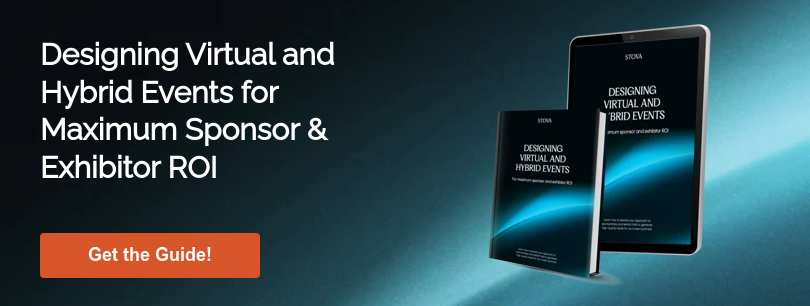After the pandemic, the event industry experienced a resurgence of in-person, onsite demand, and the massive market potential for purely virtual events more or less evaporated. But that isn’t to say that virtual event components don’t have an ongoing role to play in supporting a range of event types and goals.
According to Freeman research (cited by Catherine McNeil, director of operations at the Ice Cream & Artisan Food Show on TSNN), “46% of guests at a trade show only attend one show a year.” This figure is likely to grow with increasing uncertainty around the practicality and safety of travel to the US. That, compounded by rising costs exacerbated by shifting and unpredictable international trade policies, could mean a revival of virtual engagement:
“The international attendees, from Canada to Europe, are overwhelmingly choosing to attend virtually because of concern about safety, visa issues, and how their company’s decision to attend might be perceived publicly,” said Lindsay Martin-Bilbrey, an event consultant with Nifty Method, in a recent Skift article.
Virtual event platforms remain a reliable way to expand the reach of an event, accommodate stakeholders near and far, bolster sponsorship packages, increase marketing potential, and create new and novel event experiences.
Here are five reasons virtual event elements can still enhance an event and boost its ROI in 2025.
1. Reaching New Audiences and Accommodating New Priorities
One of the most enduring values of hybrid and virtual components is their ability to make events more accessible. As many organizations recalibrate their risk tolerance for international events, virtual access gives those unable to travel a way to participate meaningfully, whether due to cost, geography, visa complications, or safety concerns.
Beyond individual accessibility, virtual components help to tap into entirely new audience segments. For example, an executive might attend in person while their regional team joins virtually. An international stakeholder might use the virtual environment to assess whether it’s worth investing in an in-person event the following year. These hybrid pathways allow organizers to build long-term relationships and nurture broader interest without being constrained by physical access.
Hybrid is, above all, a format for flexibility that offers attendees options based on their role, location, priorities and bandwidth.
Find out how Stova can help you expand your options while maintaining the quality of the experience across all channels. Book a demo.
2. Boosting Event Marketing Through Online Engagement
Virtual platforms create new touchpoints throughout the event lifecycle that can amplify event marketing and brand presence. Pre-event teasers, virtual networking lounges and digital sponsor activations can be woven into promotional campaigns to build momentum in the lead-up to the event.
During the event, digital participation creates valuable real-time social content as well. Screenshots from keynote live streams, snippets from chat discussions and highlights from interactive polls can all be shared across all channels to extend an event’s visibility and encourage FOMO among those who didn’t register. This is especially useful for B2B events, where industry recognition and thought leadership are critical to brand value.
Post-event, an event’s virtual platform becomes a marketing engine for future programs. Session recordings, digital sponsor content and attendee testimonials can be repackaged and shared as gated content to drive lead generation or openly on social media to drive registrations. Virtual events and sessions are not just capturing attention for one moment in time, they’re building a year-round pipeline of interest that supports ongoing campaigns and nurtures new audiences.
Find out how to stream high quality virtual sessions and then maximize that content online using Stova’s AI-powered content engine.
3. Building the Infrastructure for Community Engagement
Virtual platforms are less about replicating the event experience than they are about expanding it. According to research by Freeman, over 90% of respondents to their survey across generations want to see more of “a balance between technology and in-person opportunities” to stay connected, both internally within their organizations and throughout their industries more broadly.
In this way, they are also a powerful tool for fostering a sense of community that continues long after the event ends. A well-designed digital layer supports the shift from one-off gatherings to ongoing audience engagement by giving attendees a place to continue conversations, revisit content and form new connections.
This is facilitated in a virtual environment through chat threads, discussion forums, breakout rooms and AI-assisted matchmaking tools that can integrate online and onsite audiences to create community-building spaces. When attendees see real value in ongoing dialogue and have a curated space to continue it (especially if prompted with timely virtual content), they’re more likely to stay engaged between annual events.
For organizers, these touchpoints offer new revenue streams and engagement metrics that aren’t tied to venue walls or event timelines. Depending on what kind of event the community is built around, access need not be limited to attendees. Sponsors, exhibitors and speakers can also benefit from these extended interactions by, for instance, hosting virtual roundtables to keep their brand top-of-mind.
4. Delivering Resources to Foster Trust and Loyalty
Like many marketers, many event organizers (and their audiences, frankly) struggle with content saturation. By serving as a space where this content can be curated and analyzed by the experts, a well-executed virtual event platform can extend an event into a long-term resource hub. On-demand access to session recordings, downloadable resources and other materials ensures ongoing value delivery well after the event is over.
This is particularly valuable for educational or thought leadership events, as access to high-quality content is central to their value proposition and typically part of a broader content marketing and credentialing strategy. Attendees appreciate being able to revisit complex sessions or catch up on content they missed, and organizers benefit by keeping their event platform relevant.
Sponsors and exhibitors can also benefit from a credible place to deliver educational content that allows them to reach an audience that might not be as receptive to self-published materials. While they often have valuable expertise and sophisticated insights on industry trends, audiences don’t like to be marketed to. Having a reputable event brand act as a curator both offers a platform to reach new audiences and lends credibility to a sponsor’s voice – especially where the marketing angle is dialed down and the unbiased analyses are dialed up.
5. Generating Valuable Data to Improve Each Iteration of the Event
Perhaps the most powerful benefit of virtual event components is the wealth of data they generate. Every digital interaction, from session attendance and networking matches to Q&A submissions and virtual booth clicks, provides insights that an organizer can action to improve their events.
This kind of granular behavioral and engagement data goes far beyond post-event surveys. Organizers can see which sessions generated the most attention, which sponsors had the highest engagement or which user personas interacted most with specific features of the event. Over time, these insights become the foundation for stronger programming decisions, better sponsorship packages and more personalized attendee experiences.
Event organizers are expected to demonstrate clear ROI, not just to sponsors and exhibitors but also to internal stakeholders. Hybrid events make that easier by enabling detailed reporting. With customizable dashboards and integrated analytics tools, platforms like Stova make it simple to extract the data that matters, so organizers can act on it with confidence.
Hybrid Isn’t Dead, It’s Evolving
Hybrid and virtual elements may no longer be the headline-grabbing innovations they were in 2020, but they’ve found their place as indispensable tools in the modern event planner’s larger engagement strategy. Now, virtual event components are less about replacing the in-person experience and more about enhancing it by extending reach, enriching engagement and maximizing ROI.
Find out how to future-proof your event program and deliver value that extends well beyond the check out. Book a demo.


